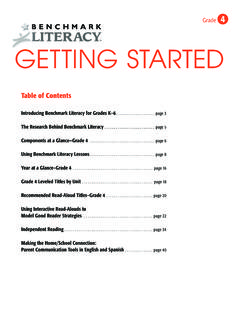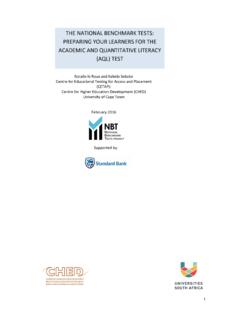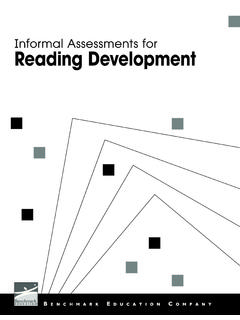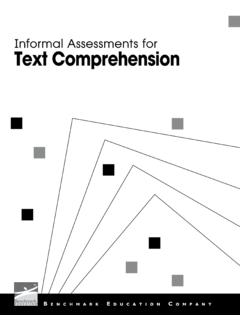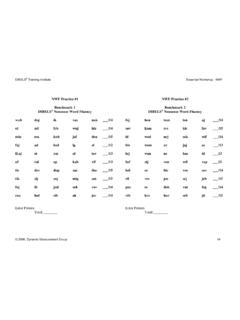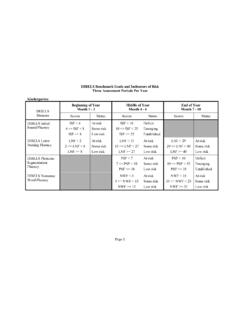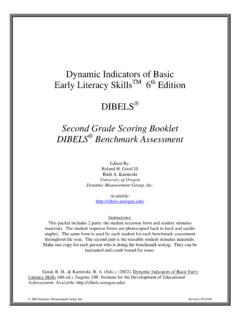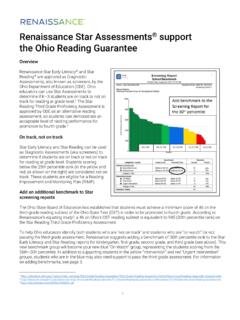Transcription of Standards and benchmarks reflect the knowledge and skills ...
1 * Standards and benchmarks reflect the knowledge and skills that a child on a developmental trajectory (progression) should know and be able to do at the end of the age-related timeframe. Form OEL-VPK 15 (October 2017) Draft Rule 6M-8602 FAC HOW TO USE THE S TANDARDS F OR C HI LDREN 4 YEARS OLD TO KINDERGARTEN The domains, or areas of develo pment, are a useful way to look at the develo pmental progression of related s kills and abilities of childre n. They are i dentif ied with a capital Roman numeral ( , I, II, III). Each domain is further divided into components, sub-components (where applicable ), Standards , and where appropriate, benchmar ks. Components are the organizing concepts of each domain and re pre sent the major topics to be addressed during each age ra nge.
2 They are identif ied in t he color of the domain with a capital letter ( , A, B, C). Standards are expectations of what children should know and be able to do by the end of each age ra nge; they are i dentif ied by a numeral ( , 1, 2, 3). A desc ription of each standard is also provided. benchmarks are more precise than Standards and are set to reflect the level of skill and knowledge that should be demonstra ted by a child at the end of the experience for each age ra nge ( , a, b, c). The purpose of these benchmarks is to establi sh goals for children that maximize their chances for success. Examples provided to clarify Standards and benchmarks do not represent an inclusive list of all possible examples. Standards and benchmarks refle ct the knowle dge and skills that a child on a developmental trajectory (pro gression) should know and be able to do at the end of the age-related timefra me.
3 Standards and benchmarks can assist teachers in p la nning instruction and discussing expectatio ns and growth with a child s family. The Standards for 4 Years Old t o Kindergarten are grouped around eight domains of early learning and development: I. Physical Development II. Approaches to Learning III. Social and Emotional Development IV . Language and Li te ra cy V. Mathematical Thinking VI. Scient if ic Inquiry VII. Social Studies VIII. Creative Expression Through the Arts * Standards and benchmarks reflect the k nowle dge and skills that a child on a developmental trajectory (progre ssion) should k now and be able to do at the end of the age-related timeframe. Form OEL-VPK 15 (October 2017) Rule , 1 Form OEL-VPK 15 (October 2017) Rule , * Standards and benchmarks reflect the knowledge and skills that a child on a developmental trajectory (progression) should know and be able to do at the end of the age-related timeframe.
4 2 I. PHYSICAL DEVELOPMENT DOMAIN * A. HEALTH AND WELLBEING a. Active Physical Play 1. Engages in physical activities with increasing balance, coordination, endurance and intensity Benchmark a: Seeks to engage in physical activities or active play routinely with increased intensity and duration b. Safety 1. Shows awareness of safety and increasingly demonstrates knowledge of safe choices and risk assessment when participating in daily activities Benchmark a: Consistently follows basic safety rules independently across different situations Benchmark b: Identifies consequences of not following safety rules c. Personal Care Routines 1. Responds to and initiates care routines that support personal hygiene Benchmark a: Initiates and completes familiar hygiene routines independently d.
5 Feeding and Nutrition 1. Responds to feeding or feeds self with increasing efficiency and demonstrates increasing interest in eating habits and making food choices Benchmark a: Assists adults in preparing simple foods to serve to self or others Benchmark b: Recognizes nutritious food choices and healthy eating habits B. MOTOR DEVELOPMENT a. Gross Motor Development 1. Demonstrates use of large muscles for movement, position, strength and coordination Benchmark a: Balances, such as on one leg or on a beam, for longer periods of time both when standing still and when moving from one position to another Benchmark b: Demonstrates more coordinated movement when engaging in skills , such as jumping for height and distance, hopping and running Benchmark c: Engages in more complex movements ( , riding a tricycle with ease) Benchmark d: Engages in physical activities of increasing levels of intensity for sustained periods of time 2.
6 Demonstrates use of large muscles to move in the environment Benchmark a: Combines and coordinates more than two motor movements ( , moves a wheelchair through an obstacle course) b. Gross Motor Perception (Sensorimotor) 1. Uses perceptual information to guide motions and interactions with objects and other people Benchmark a: Acts and moves with purpose and independently recognizes differences in direction, distance and location Benchmark b: Demonstrates spatial awareness through play activities Form OEL-VPK 15 (October 2017) Rule , * Standards and benchmarks reflect the knowledge and skills that a child on a developmental trajectory (progression) should know and be able to do at the end of the age-related timeframe. 3 c. Fine Motor Development 1. Demonstrates increasing precision, strength, coordination and efficiency when using hand muscles for play and functional tasks Benchmark a: Shows hand control using various drawing and art tools with increasing coordination 2.
7 Increasingly coordinates hand and eye movements to perform a variety of actions with increasing precision Benchmark a: Easily coordinates hand and eye movements to carry out tasks ( , working on puzzles or stringing beads together) Benchmark b: Uses developmentally appropriate grasp to hold and manipulate tools for writing, drawing and painting Benchmark c: Uses coordinated movements to complete complex tasks ( , cuts along a line, pours or buttons, buckles/unbuckles, zips, snaps, laces shoes, fastens tabs) II. APPROACHES TO LEARNING DOMAIN * A. EAGERNESS AND CURIOSITY 1. Shows increased curiosity and is eager to learn new things and have new experiences B. PERSISTENCE 1. Attends to tasks for a brief period of time C. CREATIVITY AND INVENTIVENESS 1. Approaches daily activities with creativity and inventiveness D.
8 PLANNING AND REFLECTION 1. Demonstrates some planning and learning from experiences III. SOCIAL AND EMOTIONAL DEVELOPMENT DOMAIN * A. EMOTIONAL FUNCTIONING 1. Expresses, identifies and responds to a range of emotions Benchmark a: Recognizes the emotions of peers and responds with empathy and compassion 2. Demonstrates appropriate affect (emotional response) between behavior and facial expression Benchmark a: Demonstrates cognitive empathy (recognizing or inferring other s mental states) and the use of words, gestures and facial expressions to respond appropriately B. MANAGING EMOTIONS 1. Demonstrates ability to self-regulate Benchmark a: Recognizes and names own emotions and manages and exhibits behavioral control with or without adult support Form OEL-VPK 15 (October 2017) Rule , * Standards and benchmarks reflect the knowledge and skills that a child on a developmental trajectory (progression) should know and be able to do at the end of the age-related timeframe.
9 4 2. Attends to sights, sounds, objects, people and activities Benchmark a: Increases attention to preferred activities and begins to attend to non-preferred activities C. BUILDING AND MAINTAINING RELATIONSHIPS WITH ADULTS AND PEERS 1. Develops positive relationships with adults Benchmark a: Shows enjoyment in interactions with trusted adults while also demonstrating skill in separating from these adults 2. Develops positive relationships with peers Benchmark a: Plays with peers in a coordinated manner including assigning roles, materials and actions Benchmark b: Maintains friendships and is able to engage in prosocial behavior such as cooperating, compromising and turn-taking Benchmark c: Responds appropriately to bullying behavior 3. Develops increasing ability to engage in social problem solving Benchmark a: Able to independently engage in simple social problem solving including offering potential solutions and reflecting on the appropriateness of the solution 4.
10 Exhibits empathy by demonstrating care and concern for others Benchmark a: Able to take the perspective of others and actively respond in a manner that is consistent and supportive D. SENSE OF IDENTITY AND BELONGING 1. Develops sense of identity and belonging through play Benchmark a: Engages in associative play and begins to play cooperatively with friends 2. Develops sense of identity and belonging through exploration and persistence Benchmark a: Persists at individual planned experiences, caregiver-directed experiences and planned group activities 3. Develops sense of identity and belonging through routines, rituals and interactions Benchmark a: Demonstrates willingness to be flexible if routines must change 4. Develops sense of self-awareness and independence Benchmark a: Uses words to communicate personal characteristics, preferences, thoughts and feelings Benchmark b: Recognizes preferences of others Benchmark c: Uses words to demonstrate knowledge of personal information ( , hair color, age, gender or size) Benchmark d: Identifies self as a unique member of a group ( , class, school, family or larger community) Form OEL-VPK 15 (October 2017) Rule , * Standards and benchmarks reflect the knowledge and skills that a child on a developmental trajectory (progression) should know and be able to do at the end of the age-related timeframe.
